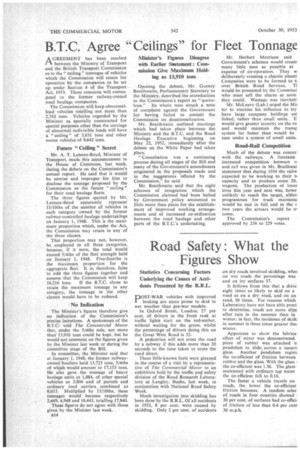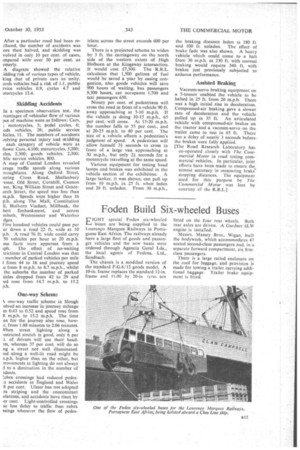Road Safety: What the Figures Show
Page 48

Page 49

If you've noticed an error in this article please click here to report it so we can fix it.
Statistics Concerning Factors Underlying the Causes of Accidents Presented by the R.R.L.
POST-WAR vehicles with improved braking are more prone to skid in wet weather than pre-war models.
In Oxford Street, London, 27 per cent. of drivers in the front rank at traffic lights start OD the red-amber, without waiting for the green, whilst the percentage of drivers doing this on the 'Great West Road is 52.
A pedestrian will not cross the road by a subway if this adds more than 20 seconds to the time taken to cross the road direct.
These little-known facts were gleaned in the course of a visit by a representative of The Commercial Motor to an exhibition held by the traffic and safety division of the Road Research Laboratory at Langley, Bucks, last week, in conjunction with National Road Safety Week.
Much investigation into skidding has been done by the R.R.L, Of all accidents in 1952, 8 per cent, were caused by skidding. Only 2 per cent of accidents on dry roads involved skidding, whet on wet roads the percentage was and on icy surfaces 57.
It follows from this that a drive eight times as likely to skid on a road as on a dry road, and on an road, 30 times. For reasons which Laboratory have not been able preci: to determine, roads are more slipr after rain in the summer than in winter; in fact, the incidence of skidc in summer is three times greater thai winter.
Apparatus to show the lubrica effect of water was demonstrated. piece of rubber was attached tc pendulum to slide, across a square glass. Another pendulum registt the co-efficient of friction between rubber and the glass. With the glass the co-efficient was 1.36. The glass moistened with ordinary tap water the to-efficient fell to 0.16.
The faster a vehicle travels on roads, the lower the co-efficient friction becomes. A random selec of roads in four counties showed : 30 per cent. of surfaces had co-efficii of friction of less than 0.4 per cent 30 m.p.h.
After a particular road had been rerfaced, the number of accidents was ore than halved, and skidding was volved in only 10 per cent, of cases, Lmpared with. over 50 per cent. as rmerly.
A diagram showed the relative idding risk of various types of vehicle, king that of private cars as unity. nods vehicles had a risk of 1.1, public rvice vehicles 0.9, cycles 4.7 and otorcycles 12.4.
Skidding Accidents
In a specimen observation test, the rcentages of vehicular flow of various peg of machine were as follows: Cars, ; motorcycles, 5; pedal cycles, 6; ods vehicles, 26; public service hides, II. The numbers of accidents ,7olving personal injury and skidding each category of vehicle were as llows: Cars, 4,100; motorcycles, 5,200; des, 2,300; goods vehicles, 2,300; blic service vehicles, 800.
A map of Central London revealed erage traffic speeds along various )roughfares. Along Oxford Street, Laring Cross Road, Shaftesbury Fenue, Old Street, Cornhill, Cannon .eet, King Wi11im Street and Graceurch Street, the speed was less than m.p.h. Speeds were higher than 16 p.h. along The Mall, Constitution II, Holborn Viaduct, Millbank, the bert Embankment, and across mbeth, Westminster and Waterloo dges.
Five hundred vehicles could pass per ur down a road 22 ft. wide at 10 p.h. A road 76 ft. wide could carry 50 vehicles per hour at 20 m.p.h. ese facts were apparent from a Lph. The effect of no-waiting trictions in Central London was that L number of parked vehicles per mile from 44 to 16 and journey speed ,e from 8 m.p.h. to 8.7 m.p.h., whilst the suburbs the number of parked tides dropped from 42 to 29 and Led rose from 14.7 m.p.h. to 15.2 P.h.
One-way Scheme
k one-way traffic scheme in Slough olved an increase in journey mileage m 0.43 to 0.52 and speed rose from & m.p.h. to 15.2 m.p.h. The time en for the journey also rose, howT, from 1.88 minutes to 2.06 minutes. When street lighting along a estricted stretch is good, only 6 per Lt. of drivers will use their headits, whereas 37 per cent. will do so ng a street not well illuminated. :ed along a well-lit road might be a.p.h. higher than on the other, but novements in lighting do not always to a diminution in the number of idents.
!ebra crossings had reduced pcdes.n accidents in England and Wales 8 per cent, Ulster has not adopted ra striping and the concomitant ulations, and accidents have risen by er cent. Light-controlled crossings se less delay to traffic than zebra ssings wherever the flow of pedes trians across the street exceeds 600 per hour.
There is a projected scheme to widen by 3 ft. the carriageway on the north side of the western extent of High Holborn at the Kingsway intersection. It would cost (7,500. The R.R.L. calculates that 1,500 gallons of fuel would be saved a year by easing congestion, also goods vehicles will save 900 hours of waiting, bus passengers 9,300 hours, car occupants 1,700 and taxi passengers 650.
Ninety per cent. of pedestrians will cross the road in front of a vehicle 90 ft. away approaching at 5-10 m.p.h. If the vehicle is doing 10-15 m.p.h., 65 per cent. will cross. At 15-20 m.p.h. the number falls to 55 per cent., and at 20-25 m.p.h. to 40 per cent. The size of a .vehicle affects a pedestrian's judgment of speed. A pedestrian will allow himself 3f seconds to cross in front of a large van approaching at 30 m.p.h., but only 21 seconds for a motorcycle travelling at the same speed.
Various equipment for testing head lamps and brakes was exhibited in the vehicle section of the exhibition. A large tanker, it was shown, can pull up from 10 mph. in 25 ft. when laden and 20 ft. unladen. From 30 m.p.h., the braking distance laden is 180 ft and 100 ft. unladen. The effect of brake fade was also shown. A heavy vehicle which could come to a halt from 30 m.p.h. in 230 ft. with normal braking would require 340 ft. with brakes just previously subjected to arduous performance.
Assisted Braking
Vacuum-servo braking equipment on a 5-tonner enabled the vehicle to be halted in 25 ft. from 20 m.p.h. There was a high initial rise in deceleration. Compressed-air braking gave a slower rate of deceleration and the vehicle pulled up in 35 ft. An articulated vehicle with compressed-air brakes on the tractor and a vacuum-servo on the trailer came to rest in 65 ft. There was a delay of nearly 3 seconds before the brake& were fully applied.
[The Road Research Laboratory has co-operated closely with The Commercial Motor in road testing commercial vehicles. in particular, joint efforts have been made to ensure the utmost accuracy in measuring brake stopping distances. The equipment used for this purpose by The Commercial Motor was lent by courtesy of the R.R.L.]




















































































